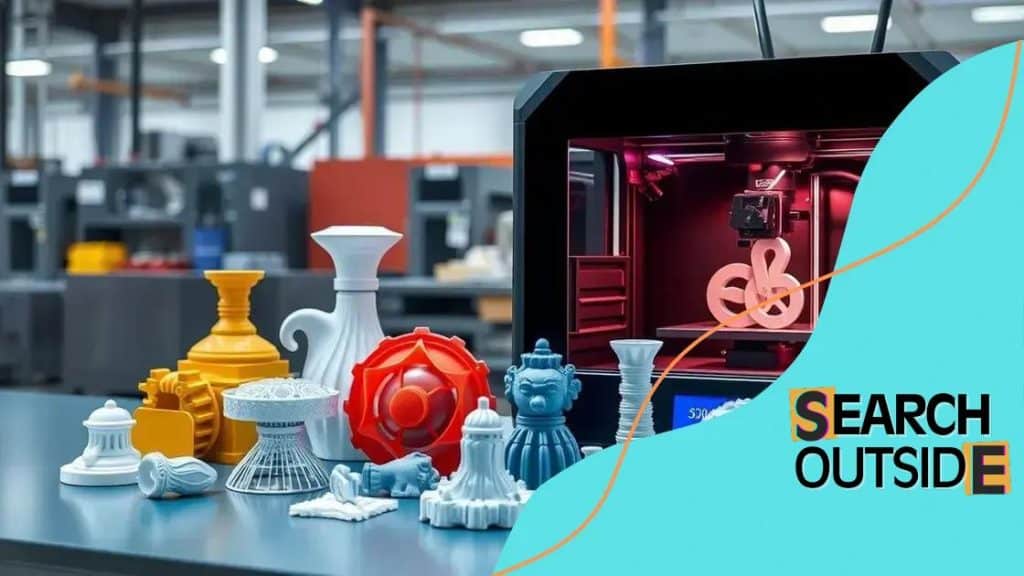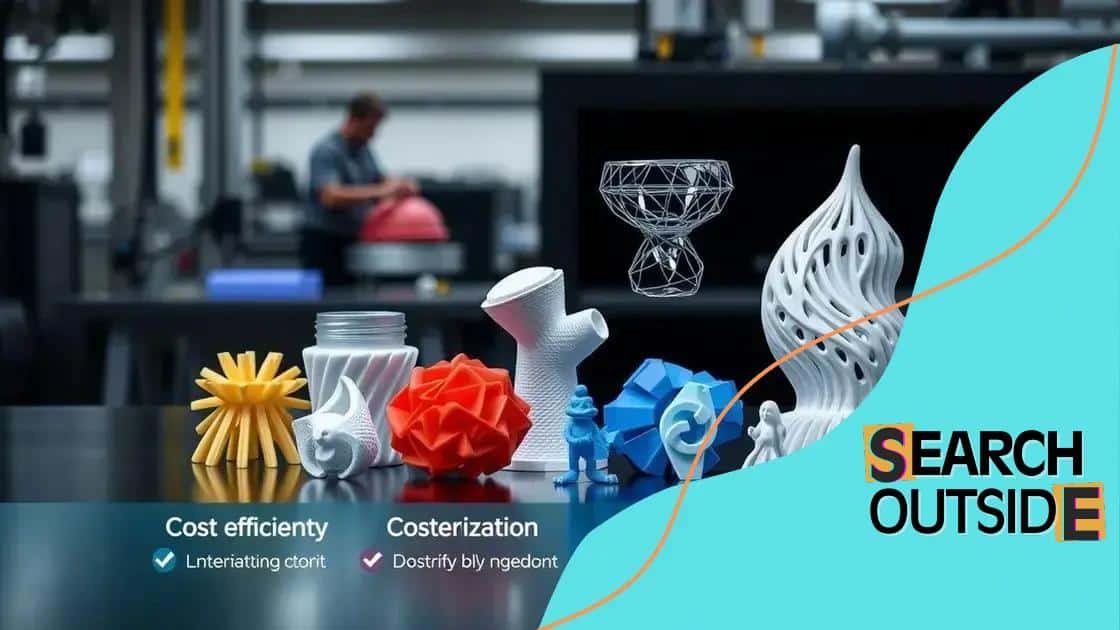How 3D printing is disrupting manufacturing industries

3D printing is transforming manufacturing industries by enabling cost-efficient production, customization, faster prototyping, and innovative designs, while also facing challenges like material limitations and quality control issues.
How 3D printing is disrupting manufacturing industries opens up a conversation about innovation. Have you ever imagined how this technology could reshape the way things are made? In this article, we explore its impact and potential.
Understanding the fundamentals of 3D printing
Understanding the fundamentals of 3D printing is essential as this technology reshapes various industries. With its innovative approach to manufacturing, 3D printing allows for incredible versatility and creativity in production.
What is 3D printing?
3D printing, also known as additive manufacturing, is a process that creates three-dimensional objects by layering materials based on digital models. Unlike traditional methods that often require cutting or molding materials, 3D printing builds items layer by layer, which significantly reduces waste.
How does it work?
The process begins with creating a digital design using computer-aided design (CAD) software. Once the design is finalized, a 3D printer reads the file and starts the manufacturing process, laying down materials such as plastic, metal, or resin.
- Layer by layer construction.
- Materials used include plastics, metals, and ceramics.
- Can produce complex geometries.
- Accessible for small batch productions.
This method is excellent for creating detailed prototypes or custom parts. As 3D printing evolves, it opens up new opportunities, allowing businesses to produce items that were previously too complex or expensive to make.
One of the core advantages of 3D printing is its efficiency. It reduces the time required for production significantly, enabling faster turnaround times in manufacturing. This is particularly beneficial in industries that thrive on rapid innovation.
Applications of 3D printing
3D printing has widespread applications across various sectors, from healthcare to aerospace. In healthcare, for instance, it allows for the creation of custom medical implants tailored to individual patient needs.
The technology also plays a crucial role in creating prototypes for engineering projects, facilitating quick adjustments based on testing and feedback. As industries continue to explore the capabilities of 3D printing, more applications are likely to emerge.
In conclusion, understanding the fundamentals of 3D printing not only highlights its transformative power but also its potential to drive innovation across multiple fields. As more businesses adopt this technology, its impact on manufacturing industries will only grow.
Key industries transformed by 3D printing
Key industries transformed by 3D printing have experienced profound changes. This technology has advanced beyond prototyping, now reshaping production and customization.
Healthcare Industry
The healthcare field is perhaps one of the most significantly impacted. 3D printing enables the creation of patient-specific implants and prosthetics, making treatments more personalized. For instance, surgical guides and custom braces can be manufactured rapidly.
- Creation of custom implants.
- Prototyping medical devices faster.
- Reduced costs in manufacturing.
- Improved patient outcomes and satisfaction.
Moreover, 3D printing allows researchers to develop organic tissues, paving the way for future advancements in regenerative medicine. As techniques improve, we can expect even more revolutionary applications.
Aerospace Industry
The aerospace sector also benefits significantly from 3D printing. Components that were previously complex to manufacture can now be produced with ease. This not only reduces the weight of parts but also enhances fuel efficiency.
By utilizing strong yet lightweight materials, manufacturers can design and produce intricate components that were once deemed unfeasible.
- Lightweight components lead to fuel savings.
- Rapid prototyping accelerates testing.
- Reduction in waste during production.
- Customization for specific aircraft models.
As this industry continues to adopt 3D printing, we may see a shift in how air travel is approached, with more efficient designs becoming the norm.
Automotive Industry
In the automotive sector, 3D printing is revolutionizing how parts are manufactured. Car manufacturers are using this technology to produce lightweight parts that enhance vehicle performance. Customized designs can be created quickly, which increases efficiency in both production and inventory management.
Additionally, the potential for rapid prototyping allows for quicker iterations in design, ultimately leading to better products.
- Increased speed in production cycles.
- Cost-effective prototypes for testing.
- Reduction of parts in assembly.
- Enhanced performance of vehicles.
This shift in the automotive industry shows just how impactful 3D printing can be for innovative designs and sustainable practices.
Across these key industries, the transformative power of 3D printing continues to drive innovation. As businesses explore and adopt this technology, we can expect to see even more breakthroughs that reshape traditional manufacturing processes.
Benefits of 3D printing over traditional methods

The benefits of 3D printing over traditional methods are becoming increasingly clear as industries adapt to this innovative technology. 3D printing offers unique advantages that revolutionize how we think about manufacturing.
Cost Efficiency
One of the most significant benefits is the cost efficiency of 3D printing. Traditional manufacturing often requires expensive molds and tools, which can drive up costs. With 3D printing, you can create parts directly from digital files, reducing waste and minimizing production costs.
- Lower material waste due to precise builds.
- No need for expensive tooling or molds.
- Cost-effective for small batches of products.
- Faster turnaround times reduce overall costs.
This cost efficiency makes 3D printing highly appealing for startups and small businesses looking to innovate without a massive investment.
Customization
3D printing excels in customization. Unlike traditional methods that produce items in bulk, 3D printing allows for individual adjustments without additional costs. Businesses can create tailored products suited to specific needs.
This level of customization is invaluable in various sectors, including healthcare, where personalized medical devices can be made for individual patients. Brands can also offer unique designs that stand out in the marketplace.
Speed and Efficiency
Another critical benefit is the speed of production. 3D printing can drastically shorten the design-to-manufacture timeline. Traditional methods may take weeks or months to develop a prototype, while 3D printing can often produce one in a matter of days.
- Rapid prototyping allows for quicker iterations.
- Faster delivery times for final products.
- Shortens time to market for new ideas.
- Increased productivity for manufacturers.
This speed enables businesses to respond promptly to market demands and reduces the time it takes for innovations to reach consumers.
Design Freedom
Lastly, 3D printing provides unparalleled design freedom. Designers can create complex shapes and structures that are impossible or prohibitively expensive to produce with traditional methods. This opens a world of possibilities for creativity and functionality.
With enhanced design capabilities, industries can explore new ways of building products that are both lightweight and durable, enhancing performance without sacrificing quality.
Challenges and limitations of 3D printing
While 3D printing offers numerous advantages, it also comes with challenges and limitations that cannot be overlooked. Understanding these obstacles is crucial for industries looking to adopt this technology successfully.
Material Limitations
One significant challenge is the limited range of materials available for 3D printing. Although the selection has grown, certain high-performance materials remain out of reach. Most 3D printing processes are still predominantly focused on plastics, which might not always meet the requirements for strength and durability in various applications.
- Limited availability of high-performance metals.
- Challenges in achieving specific material properties.
- Increased costs for specialty materials.
- Restrictions on environmental factors affecting material use.
This limitation in materials can restrict the scope of projects and applications in various industries.
Production Speed
Another issue is the speed of production. Although 3D printing can produce complex designs more quickly than traditional methods, it is still often slower when mass production is needed. For large production runs, traditional manufacturing methods can be more efficient.
As a result, companies may struggle to meet high-volume orders effectively while relying solely on 3D printing technology.
Quality and Accuracy
Quality control is another concern with 3D printing. While many printers can create highly detailed objects, maintaining consistency across many printed parts can be complex. Variations in temperature and material can lead to defects or inaccuracies.
- Possible inconsistencies between printed items.
- Challenges in achieving precise tolerances.
- Dependence on printer calibration and maintenance.
- Risk of part failure or shorter lifespan.
These quality issues can affect the reliability and safety of the produced parts, especially in critical applications such as aerospace and healthcare.
Intellectual Property Concerns
Lastly, intellectual property (IP) concerns are significant. As 3D printing continues to grow, the potential for IP theft increases. Digital files can be easily shared or replicated, leading to misuse of designs and intellectual property violations. Protecting these assets becomes a challenge for innovators.
Companies must navigate these complex legal landscapes to ensure their designs remain protected while leveraging 3D printing technology.
Future trends in 3D printing technology
Future trends in 3D printing technology promise exciting advancements that may further revolutionize industries worldwide. As this technology evolves, we can expect to see significant changes that enhance efficiency, sustainability, and creativity.
Advancements in Material Science
One of the most significant trends is the development of new materials specifically designed for 3D printing. Researchers are exploring advanced composites, metals, and bio-materials that could create stronger and more durable products. The ability to print with materials that mimic biological structures may lead to breakthroughs in healthcare and regenerative medicine.
- Increased strength and durability of printed items.
- Use of biodegradable materials for sustainability.
- Innovative bio-printing techniques for medical applications.
- Expanded range of materials for various industries.
This enhanced material diversity will open doors for 3D printing applications across many sectors.
Integration with AI and Automation
Another noteworthy trend involves the integration of artificial intelligence (AI) and automation within 3D printing processes. AI can optimize designs and manufacturing workflows, improving efficiency and reducing errors. Through machine learning, printers can learn from previous jobs to enhance future performance and outcomes.
This merging of technologies allows for smart manufacturing solutions that adapt and evolve, providing manufacturers with tools to streamline production.
Increased Customization and Personalization
As consumer preferences shift towards personalized products, 3D printing will increasingly cater to this demand. More businesses will adopt technologies that allow for customizable designs tailored to individual needs. This flexibility will not only enhance customer satisfaction but also create opportunities for niche markets.
- Customized products become mainstream.
- Mass customization for larger brands.
- Greater consumer engagement in product design.
- Potential for limited edition and unique items.
With more companies embracing this trend, the market space will continue to expand in exciting ways.
Sustainability Initiatives
Sustainability remains a critical focus area for many sectors, and 3D printing is no exception. Future advancements will emphasize eco-friendly practices, including the use of recycled materials and energy-efficient printing processes. As industries seek to reduce their carbon footprints, 3D printing can play a significant role in promoting sustainable manufacturing.
These initiatives may change how products are developed and disposed of, leading to more sustainable resources.
FAQ – Frequently Asked Questions about 3D Printing Technology
What are the main benefits of 3D printing?
The main benefits of 3D printing include cost efficiency, customization, speed of production, and design freedom, making it ideal for various industries.
What challenges does 3D printing face?
Challenges include limited material options, production speed for mass manufacturing, quality control, and intellectual property concerns.
How is AI integrated into 3D printing?
AI can optimize designs and workflows in 3D printing, improving efficiency, reducing errors, and enabling smart manufacturing solutions.
What trends are shaping the future of 3D printing?
Key trends include advancements in material science, increased customization options, sustainability initiatives, and greater integration with automation and AI.





